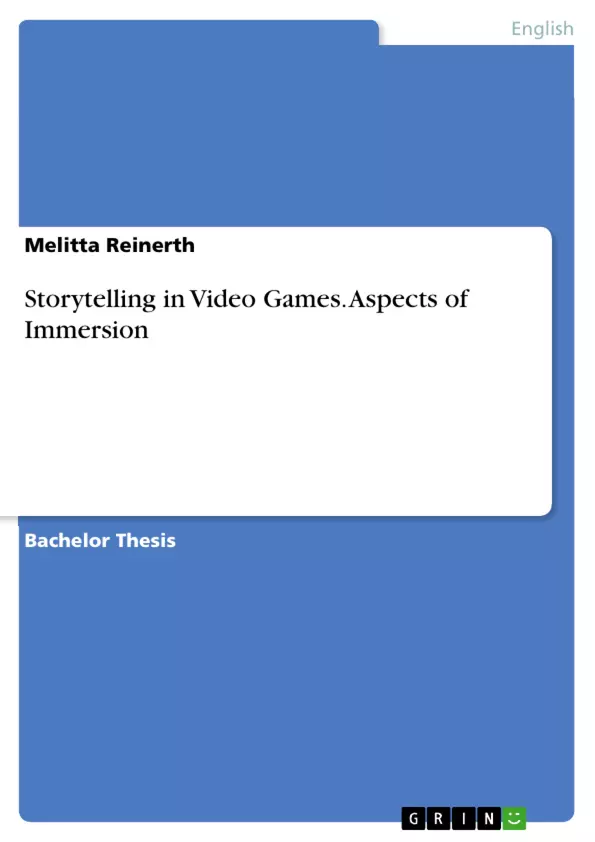
Storytelling in Video Games. Aspects of Immersion
Bachelorarbeit, 2021
49 Seiten, Note: 1,7
Leseprobe
Inhaltsverzeichnis (Table of Contents)
- 1. Introduction
- 2. Theoretical Framework
- 2.1. The Term of Literature
- 2.2 A brief History of Video Games
- 2.3. Narrative Concepts
- 2.3.1. Act-structure
- 2.3.2. Chapters to structure story
- 2.3.3. The Geometric Design Structure
- 2.4. Ludology versus Narratology
- 3. Experience of Virtual Spaces
- 3.1. Interaction versus Narrative
- 3.2. Immersion and Player Involvement
- 3.3 Space and Time in Video Games
- 4. Conclusion
Zielsetzung und Themenschwerpunkte (Objectives and Key Themes)
This thesis aims to explore the aspects of storytelling in video games and how they transport a story to the player. It examines the evolution of storytelling across different media, focusing on the unique challenges and opportunities presented by video games. The thesis investigates the interplay between narrative and interaction, exploring how these elements contribute to player immersion.
- The evolution of storytelling from oral traditions to video games.
- The application of narrative structures (e.g., act-structure, The Hero's Journey) to video games.
- The relationship between ludology and narratology in video game studies.
- The role of interaction and immersion in shaping the player experience.
- The impact of space and time on immersion in video games.
Zusammenfassung der Kapitel (Chapter Summaries)
1. Introduction: This chapter introduces the concept of storytelling throughout history, emphasizing its evolution across various media, from oral traditions to novels, movies, and finally, video games. It highlights the unique interactive aspect of video games and positions the thesis's goal to analyze how these games convey narratives to players. The introduction briefly touches upon the changing nature of storytelling, moving from practical knowledge dissemination to pure entertainment, and establishing video games as a powerful and interactive storytelling medium.
2. Theoretical Framework: This chapter provides a foundational understanding of storytelling theories relevant to video game analysis. It begins by exploring the multifaceted definition of "literature," arguing that the term extends beyond written works to encompass oral narratives and other forms of storytelling. The chapter then delves into a brief history of video game development, examining its technological advancements and how these improvements have impacted the complexity and depth of narratives within the medium. The chapter introduces key narrative structures like Freytag's pyramid (adapted for video games by Tamiko Thiel), Joseph Campbell's "Hero's Journey," and the Geometric Design Structures from Samsel and Wimberly, demonstrating their applicability across various narrative forms. Finally, it addresses the ongoing debate between ludology and narratology, highlighting the challenges in applying literary theories to interactive media and examining the role of cutscenes in bridging the gap between game mechanics and narrative.
3. Experience of Virtual Spaces: This chapter delves into the unique interplay between narrative and interaction within video games, arguing that both aspects are equally crucial to the player experience. The concepts of gameplay and its relationship to narration are explained, using Far Cry 4 as an example to demonstrate the importance of interaction in unfolding the narrative. The evolution of cutscenes and their role in storytelling are discussed, highlighting their transition from mere interruptions to integral components of the narrative structure. The chapter also explores interactive fiction as an example of a genre that prioritizes story-driven gameplay, drawing on the work of Espen Aarseth and the games of Quantic Dream as examples. Finally, the chapter discusses immersion, detailing the psychological mechanisms leading to complete immersion, drawing on the models of Brown and Cairns, Pietschmann, and Ryan. It uses What Remains of Edith Finch as a case study to showcase the effect of involvement and feedback loops on immersion, and further analyzes the significance of space and time in creating a more immersive gaming environment compared to traditional media like novels and movies.
Schlüsselwörter (Keywords)
Video game storytelling, narrative structures, ludology, narratology, immersion, interaction, gameplay, cutscenes, interactive fiction, virtual spaces, player experience, narrative design.
Frequently Asked Questions: A Comprehensive Language Preview of Video Game Storytelling
What is the overall topic of this document?
This document is a comprehensive preview of a thesis exploring storytelling in video games. It covers the table of contents, objectives and key themes, chapter summaries, and keywords, providing a thorough overview of the research conducted.
What are the main objectives of the thesis?
The thesis aims to explore how video games convey stories to players, examining the evolution of storytelling in this medium and the interplay between narrative and interaction in shaping player immersion. Specific themes include the evolution of storytelling across different media, the application of narrative structures to video games, the relationship between ludology and narratology, and the role of interaction and immersion in the player experience.
What are the key themes explored in the thesis?
Key themes include the evolution of storytelling from oral traditions to video games; the application of narrative structures like Freytag's pyramid and the Hero's Journey to video game narratives; the ongoing debate between ludology (focus on gameplay) and narratology (focus on narrative); the role of interaction and immersion in shaping player experience; and the impact of space and time on immersion in video games.
What is covered in Chapter 1 (Introduction)?
Chapter 1 introduces the concept of storytelling throughout history, highlighting its evolution across various media and emphasizing the unique interactive aspects of video games. It sets the stage for the thesis by focusing on how video games convey narratives and the shift from practical knowledge dissemination to pure entertainment in storytelling.
What is covered in Chapter 2 (Theoretical Framework)?
Chapter 2 provides a theoretical foundation for analyzing video game storytelling. It explores the definition of "literature," examines the history of video game development and its impact on narrative complexity, introduces key narrative structures (Freytag's pyramid, the Hero's Journey, Geometric Design Structures), and discusses the ongoing debate between ludology and narratology. The role of cutscenes in bridging gameplay and narrative is also analyzed.
What is covered in Chapter 3 (Experience of Virtual Spaces)?
Chapter 3 delves into the interplay between narrative and interaction in video games. It examines the relationship between gameplay and narration, the evolution and role of cutscenes, and interactive fiction as a story-driven genre. The chapter explores immersion, drawing on various psychological models, and analyzes the impact of space and time on creating immersive gaming experiences using examples like Far Cry 4 and What Remains of Edith Finch.
What is the significance of Ludology versus Narratology in the thesis?
The thesis addresses the ongoing debate between ludology (which focuses on the rules and mechanics of gameplay) and narratology (which focuses on the narrative structure and storytelling), highlighting the challenges of applying traditional literary theories to interactive media and examining how these perspectives contribute to the overall player experience.
What is the role of immersion and interaction in the thesis?
The thesis emphasizes the crucial roles of immersion and interaction in shaping the player experience. It explores how these elements work together to create a compelling and engaging narrative within the interactive environment of video games, distinguishing this from traditional, passive forms of storytelling.
What are some key examples of video games used in the thesis?
The thesis uses examples like Far Cry 4 to illustrate the relationship between gameplay and narrative, and What Remains of Edith Finch to showcase the effect of involvement and feedback loops on immersion.
What are the keywords associated with this thesis?
Keywords include: Video game storytelling, narrative structures, ludology, narratology, immersion, interaction, gameplay, cutscenes, interactive fiction, virtual spaces, player experience, and narrative design.
Details
- Titel
- Storytelling in Video Games. Aspects of Immersion
- Hochschule
- Universität zu Köln (Englisches Seminar I)
- Note
- 1,7
- Autor
- Melitta Reinerth (Autor:in)
- Erscheinungsjahr
- 2021
- Seiten
- 49
- Katalognummer
- V1024815
- ISBN (eBook)
- 9783346428608
- ISBN (Buch)
- 9783346428615
- Sprache
- Englisch
- Schlagworte
- Storytelling Videogames gaming literature immerion spiele videospiele computerspiele video games playstation computer games hero's journey cybertext
- Produktsicherheit
- GRIN Publishing GmbH
- Preis (Ebook)
- US$ 21,99
- Preis (Book)
- US$ 31,99
- Arbeit zitieren
- Melitta Reinerth (Autor:in), 2021, Storytelling in Video Games. Aspects of Immersion, München, Page::Imprint:: GRINVerlagOHG, https://www.diplomarbeiten24.de/document/1024815
- Autor werden
- Ihre Optionen
- Vertriebskanäle
- Premium Services
- Autorenprofil
- Textarten und Formate
- Services für Verlage, Hochschulen, Unternehmen

- © GRIN Publishing GmbH.
- Alle Inhalte urheberrechtlich geschützt. Kopieren und verbreiten untersagt.
- info@grin.com
- AGB
- Open Publishing
Der GRIN Verlag hat sich seit 1998 auf die Veröffentlichung akademischer eBooks und Bücher spezialisiert. Der GRIN Verlag steht damit als erstes Unternehmen für User Generated Quality Content. Die Verlagsseiten GRIN.com, Hausarbeiten.de und Diplomarbeiten24 bieten für Hochschullehrer, Absolventen und Studenten die ideale Plattform, wissenschaftliche Texte wie Hausarbeiten, Referate, Bachelorarbeiten, Masterarbeiten, Diplomarbeiten, Dissertationen und wissenschaftliche Aufsätze einem breiten Publikum zu präsentieren.
Kostenfreie Veröffentlichung: Hausarbeit, Bachelorarbeit, Diplomarbeit, Dissertation, Masterarbeit, Interpretation oder Referat jetzt veröffentlichen!
- GRIN Verlag GmbH
-
- Nymphenburger Str. 86
- 80636
- Munich, Deutschland
- +49 89-550559-0
- +49 89-550559-10
- info@grin.com
-









